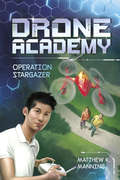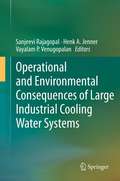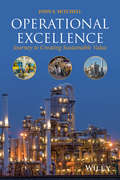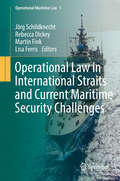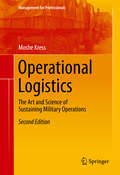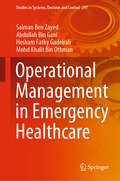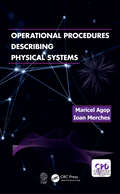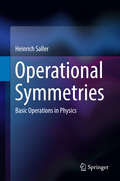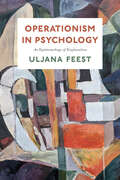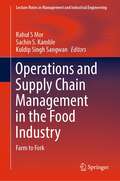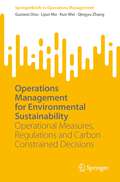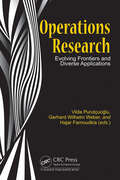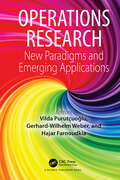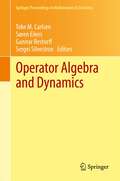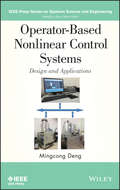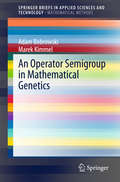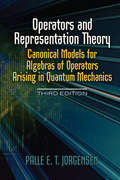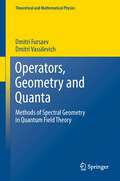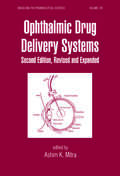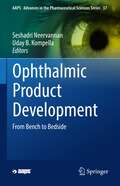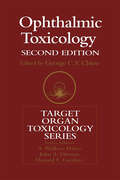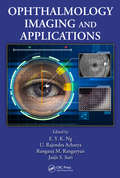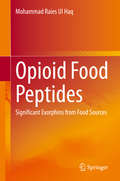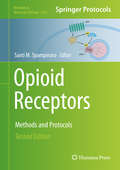- Table View
- List View
Operation Stargazer (Drone Academy)
by Matthew K. ManningWhile Howard To has always been on the geeky side, there's one girl who brings him out of his shell. Unfortunately, she's Hollywood's hottest sci-fi star and about as likely to cross Howard's path as he is likely to be struck by lightning. But when the starlet is hounded by a stalker who uses a drone to spy on her private life, Howard sees his chance to be a knight in shining armor. He employs his own drone to engage in aerial combat with the stalker's UAV, despite complaints from Parker, a fellow Drone Academy member. In the process, Howard also realizes his chance at romance may be closer to home than he realizes. . . .
Operational and Environmental Consequences of Large Industrial Cooling Water Systems
by Henk A. Jenner Vayalam P. Venugopalan Sanjeevi RajagopalThe use of water for industrial purposes is of foremost importance. It is used as a coolant and industrial activities dealing with power generation, steel and iron, paper and pulp and oil require very large amounts of water. The industry, therefore, resorts to large scale abstraction of water from natural water bodies. This water is often treated with chemicals to combat operational problems like biofouling and corrosion. Such withdrawal and subsequent discharge of large amounts of water have the potential to impart significant impact on the recipient water body. The organisms drawn along with the cooling water, as well as those residing at the discharge zone, are subjected to a combination of mechanical, thermal and chemical stress on a continuous basis.
Operational Excellence
by John S. MitchellProvides the foundation and tools that are essential for an enterprise to bring Operational Excellence into their organizational culture; gain maximum results, benefits and value Strategies for and implementing details for enterprises at all levels of maturity from those with programs in place to those looking to improve safety, health, environment performance as well as the efficiency and effectiveness of their operations Includes topics from concept to sustainability satisfying knowledge requirements of all levels in the organization Defines program objectives; develops improvement strategies; identifies and prioritizes improvement opportunities; implements improvement plans; monitors, continuously improves and sustains results Applicable to a broad variety of operating enterprises, academic institutions and third party implementing organizations
Operational Law in International Straits and Current Maritime Security Challenges (Operational Maritime Law Ser. #1)
by Lisa Ferris Martin Fink Rebecca Dickey Jörg SchildknechtThis book addresses a wide range of contemporary operational maritime law issues across the spectrum of operations. It provides sophisticated analyses and insights, and offers new interpretations of topics that are directly relevant for contemporary naval operations.The book examines unresolved legal issues in order to provide guidelines for conducting maritime operations, and also offers reference material for general education on the law of naval operations. Further, it serves as a comprehensive resource for operational doctrine and military planning, and presents an approach to dealing with multiple legal issues that demonstrates how modern military operations at sea can legally be executed. Focusing on operational and tactical topics, it is a valuable addition to the bookshelves of military lawyers and operators alike.
Operational Logistics
by Moshe KressThis book explores the theoretical foundations and applications of military operational logistics (OpLog). OpLog theory has two facets: qualitative and quantitative. The qualitative facet is imbedded in the theory of operational level of war or operational art. It includes principles, imperatives and tenets, which are stated and analyzed in the first few chapters. The quantitative facet relates to the scientific aspects of OpLog. It is manifested by formal network models representing structural and operational features of an OpLog system. The book examines the two facets and integrates them into a unified presentation. Important OpLog applications a re described and discussed. Chapter 1 presents a general introduction to military logistics. Chapter 2 discusses the px;font-family: monospace;">general structure and characteristics of logistics and describes its three levels - strategic, operational and tactical. Chapter 3 describes the foundation of OpLog. Chapter 4 deals with OpLog planning. Chapter 5 addresses the issue of logistic information, and Chapter 6 deals with forecasting logistic demands. Chapters 7 and 8 are new additions to this second edition. They address logistics aspects of two contemporary operational topics - insurgencies and humanitarian assistance. Chapter 9 describes the first version of the logistic network model. Chapter 10 addresses an important OpLog characteristic - Flexibility. Chapter 11 discusses two major challenges in OpLog practice: force accumulation, 4419px; font-family: monospace;">and medical treatment and evacuation. Chapter 12 presents an inter-temporal network optimization model designed to determine deployment and employment of 3333px;font-family: monospace;">the OpLog support chain during military operations.
Operational Management in Emergency Healthcare (Studies in Systems, Decision and Control #297)
by Salman Ben Zayed Abdullah Bin Gani Hesham Fathy Gadelrab Mohd Khalit Bin OthmanThis book presents a systematic review of research concerning processes and systems in Emergency Departments (EDs), the issues faced by EDs, and their solutions to ensure the delivery of proper and ideal healthcare services for patients through superior quality process management. The book evaluates two decades of data, from 2000 to 2019, in order to examine the processes used in ED operations.
Operational Procedures Describing Physical Systems
by Marciel Agop Ioan MerchesThe authors examine topics in modern physics and offer a unitary and original treatment of the fundamental problems of the dynamics of physical systems, as well as a description of the nuclear matter within a framework of general relativity. They show that some physical phenomena studied at two different resolution scales (e.g. microscale, cosmological scale), apparently with no connection between them, become compatible by means of the operational procedures, acting either as some ”hidden” symmetries, or harmonic-type mappings. The book is addressed to the students, researchers and university/high school teachers working in the fields of mathematics, physics, and chemistry.
Operational Symmetries
by Heinrich SallerThis book describes the endeavour to relate the particle spectrum with representations of operational electroweak spacetime, in analogy to the atomic spectrum as characterizing representations of hyperbolic space. The spectrum of hyperbolic position space explains the properties of the nonrelativistic atoms; the spectrum of electroweak spacetime is hoped to explain those of the basic interactions and elementary particles. In this book, the theory of operational symmetries is developed from the numbers, from Plato's and Kepler's symmetries over the simple Lie groups to their applications in nonrelativistic, special relativistic and general relativistic quantum theories with the atomic spectrum for hyperbolic position and, in first attempts, the particle spectrum for electroweak spacetime. The standard model of elementary particles and interactions is characterized by a symmetry group. In general, as initiated by Weyl and stressed by Heisenberg, quantum theory can be built as a theory of operation groups and their unitary representations. In such a framework, time, position and spacetime is modeled by equivalence classes of symmetry groups. For a unification on this road, the quest is not for a final theory with a basic equation for basic particles, but for the basic operation group and its representations.
Operationism in Psychology: An Epistemology of Exploration
by Uljana FeestAnalyzes psychological research to offer insights into how methodological and ontological questions are intertwined. Psychology has seen an intense debate about the lack of replicability of results in recent years. Uljana Feest uses history and philosophy of science to shed light on the nature of experiment in psychology in general, but her aim reaches beyond debates about replication to provide a novel and comprehensive analysis of the investigative process in experimental psychology. She shows that the central unit of analysis for our epistemological considerations of psychological research should be not theories but, rather, concepts. Her guiding question is: How do psychological concepts figure in the experimental exploration of the objects of psychological research? For Feest, this question has two intertwined aspects: What role do concepts play in the design of experiments and the production of data, and how can concepts be revised or adapted in response to experimental results. Following the historical trajectory of debates about operationism in psychology, she argues that this debate was not concerned with philosophical theories of meaning but, instead, closely connected to the investigative practices of experimental psychologists. The book offers a broad analytical framework for thinking philosophically about the investigative process in psychology, including analyses of the relationship between data and phenomena in psychology, the relationship between folk- and scientific psychological concepts, the relationship between genuine results and experimental artifacts, and the nature and exploration of psychological kinds.
Operations and Supply Chain Management in the Food Industry: Farm to Fork (Lecture Notes in Management and Industrial Engineering)
by Kuldip Singh Sangwan Rahul S Mor Sachin S. KambleThis book offers effective and competitive food supply chains that are the consequence of technological innovation, collaboration, small agri-food business cases, entrepreneurial opportunities, cold chain technology management, disruptive technologies, and performance assessment through empirical analysis, case studies, and multimethod research in the food industry. The book comprehensively covers different interfaces of the food supply chain including procurement, processing, distribution, consumer, i.e., farm to fork. It provides solutions to various challenges such as globalization, food recalls, technological innovations, and consumer trust. This book will be of interest to researchers in the areas of the food supply chain, operations management, industrial engineering as well as professionals in the agri-food and allied industry.
Operations Management for Environmental Sustainability: Operational Measures, Regulations and Carbon Constrained Decisions (SpringerBriefs in Operations Management)
by Guowei Dou Lijun Ma Kun Wei Qingyu ZhangThis book explores optimal decisions for companies and governments to build a sustainable supply chain and economy by applying analytical models from new perspectives. Taking differentiated carbon permit-buying and -selling prices into consideration, it investigates the optimal emission permit cap under the “cap-and-trade” regulation and discusses how to establish a two-period carbon tax scheme with a two-period planning horizon. Moreover, it examines how to balance the economic and environmental performances in a closed-loop supply chain, how to implement trade-in program when employing green technologies, and how to strategically use the blockchain technology to improve the environmental performance of supply chain under the carbon tax policy. This book is written for students and researchers who are specialized in the field of operations management with a focus on environmental sustainability. It is also beneficial for specialists and executives at companies that are facing carbon emission regulation challenges, as well as government officials who develop the emission control policies.
Operations Research: Evolving Frontiers and Diverse Applications
by Vilda Purutçuoğlu Gerhard Wilhelm Weber Hajar FarnoudkiaOperational research (OR) methods are used in many fields of sciences like computer engineering, industrial engineering, social works, business management, medical studies and finance. This book, is the second book in the series of Operational Research (OR) books. It brings together the latest advances of these methods written by experts from all over the world. The book comprises 13 chapters and is split into four main parts, i.e., OR in supply chain management, OR in production planning and inventory management, OR in signal processing and OR in social sciences. The book contains recent methodologies and comprehensive reviews where necessary, so that readers can follow up to date progress in the field while observing various applications with large datasets. The data used in the book is available in public databases. Therefore, the reader can easily access them and try their own approaches for comparison. Furthermore, since the book covers the literature reviews in each chapter, readers can both follow other benchmark techniques in the field and learn the theoretical aspects of the selected methods. In conclusion, the book will be assist in the discovery of new avenues for novel researchers who are interested in OR methods.
Operations Research: New Paradigms and Emerging Applications (International Series In Operations Research And Management Science Ser. #273)
by Vilda Purutçuoğlu Gerhard-Wilhelm Weber Hajar FarnoudkiaOperation Research methods are often used in every field of modern life like industry, economy and medicine. The authors have compiled of the latest advancements in these methods in this volume comprising some of what is considered the best collection of these new approaches. These can be counted as a direct shortcut to what you may search for. This book provides useful applications of the new developments in OR written by leading scientists from some international universities. Another volume about exciting applications of Operations Research is planned in the near future. We hope you enjoy and benefit from this series!
Operator Algebra and Dynamics
by Toke M. Carlsen Søren Eilers Gunnar Restorff Sergei SilvestrovBased on presentations given at the NordForsk Network Closing Conference "Operator Algebra and Dynamics," held in Gjáargarður, Faroe Islands, in May 2012, this book features high quality research contributions and review articles by researchers associated with the NordForsk network and leading experts that explore the fundamental role of operator algebras and dynamical systems in mathematics with possible applications to physics, engineering and computer science. It covers the following topics: von Neumann algebras arising from discrete measured groupoids, purely infinite Cuntz-Krieger algebras, filtered K-theory over finite topological spaces, C*-algebras associated to shift spaces (or subshifts), graph C*-algebras, irrational extended rotation algebras that are shown to be C*-alloys, free probability, renewal systems, the Grothendieck Theorem for jointly completely bounded bilinear forms on C*-algebras, Cuntz-Li algebras associated with the a-adic numbers, crossed products of injective endomorphisms (the so-called Stacey crossed products), the interplay between dynamical systems, operator algebras and wavelets on fractals, C*-completions of the Hecke algebra of a Hecke pair, semiprojective C*-algebras, and the topological dimension of type I C*-algebras. Operator Algebra and Dynamics will serve as a useful resource for a broad spectrum of researchers and students in mathematics, physics, and engineering.
Operator-Based Nonlinear Control Systems Design and Applications
by Mingcong DengEnables readers to master and apply the operator-theoretic approach Control of nonlinear systems is a multidisciplinary field involving electrical engineering, computer science, and control engineering. <P><P>Specifically, this book addresses uncertain nonlinearity. Beginning with how real plants are modeled as operator-based plants, the author develops a systematic methodology that enables readers to understand a quantitative stability result, a critical factor in any nonlinear control system's stability and performance. Operator-Based Nonlinear Control Systems: Design and Applications focuses on the operator-theoretic approach, offering detailed examples on how to apply it to network controlled systems. In addition to current research results, the author explores future research directions and applications of the operator-theoretic approach. The book begins with an introduction that defines nonlinear systems. Next, it covers: Robust right coprime factorization for nonlinear plants with uncertainties Robust stability of operator-based nonlinear control systems Tracking issues and fault detection issues in nonlinear control systems Operator-based nonlinear control systems with smart actuators Nonlinear feedback control for large-scale systems using a distributed control system device Throughout the book, discussions of actual applications help readers understand how the operator-theoretic approach works in practice. Operator-Based Nonlinear Control Systems is recommended for students and professionals in control theory engineering and applied mathematics. Working with this expertly written and organized book, they will learn how to obtain robust right coprime factorization for modeled plants. Moreover, they will discover state-of-the-technology research results on robust stability conditions as well as the latest system output tracking and fault detection issues that are challenging today's researchers.
Operator Methods in Quantum Mechanics (Dover Books On Physics Series)
by Martin SchechterThis advanced undergraduate and graduate-level text introduces the power of operator theory as a tool in the study of quantum mechanics, assuming only a working knowledge of advanced calculus and no background in physics. The author presents a few simple postulates describing quantum theory, gradually introducing the mathematical techniques that help answer questions important to the physical theory; in this way, readers see clearly the purpose of the method and understand the accomplishment. The entire book is devoted to the study of a single particle moving along a straight line. By posing questions about the particle, the text gradually leads readers into the development of mathematical techniques that provide the answers. Lebesgue integration theory and complex variables are sometimes involved, but most of the book can be understood without them. Exercises at the end of each chapter provide helpful reinforcement.
An Operator Semigroup in Mathematical Genetics: Lyapunov Equation Model Of Drift And Mutation: Population Dependence And Asymptotic Behavior (SpringerBriefs in Applied Sciences and Technology)
by Marek Kimmel Adam BobrowskiThis authored monograph presents a mathematical description of the time evolution of neutral genomic regions in terms of the differential Lyapunov equation. The qualitative behavior of its solutions, with respect to different mutation models and demographic patterns, can be characterized using operator semi group theory. Mutation and drift are two of the main genetic forces, which act on genes of individuals in populations. Their effects are influenced by population dynamics. This book covers the application to two mutation models: single step mutation for microsatellite loci and single-base substitutions. The effects of demographic change to the asymptotic of the distribution are also covered. The target audience primarily covers researchers and experts in the field but the book may also be beneficial for graduate students.
Operators and Representation Theory: Canonical Models for Algebras of Operators Arising in Quantum Mechanics (Dover Books on Physics #Volume 147)
by Palle E.T. JorgensenSuitable for advanced undergraduates and graduate students in mathematics and physics, this three-part treatment of operators and representation theory begins with background material on definitions and terminology as well as on operators in Hilbert space. The introductory section concludes with a look at the imprimitivity theorem, which grounds in more mathematical language the work of Wigner on representations of the Poincaré and Galilei groups.The second part of the monograph addresses the algebras of operators in Hilbert space, broadening the mathematics used in earlier versions of quantum theory. There are many examples in which the Hamiltonian, the operator that translates a quantum system in time, can be written as a polynomial in elements of an underlying Lie algebra. This section deals with properties of such operators. Part 3 explores covariant representation and connections, with a particular focus on infinite-dimensional Lie algebras. Connections to mathematical physics are stressed throughout the text, which concludes with three helpful appendixes, including a Guide to the Literature.
Operators, Geometry and Quanta
by Dmitri Fursaev Dmitri VassilevichThis book gives a detailed and self-contained introduction into the theory of spectral functions, with an emphasis on their applications to quantum field theory. All methods are illustrated with applications to specific physical problems from the forefront of current research, such as finite-temperature field theory, D-branes, quantum solitons and noncommutativity. In the first part of the book, necessary background information on differential geometry and quantization, including less standard material, is collected. The second part of the book contains a detailed description of main spectral functions and methods of their calculation. In the third part, the theory is applied to several examples (D-branes, quantum solitons, anomalies, noncommutativity). This book addresses advanced graduate students and researchers in mathematical physics with basic knowledge of quantum field theory and differential geometry. The aim is to prepare readers to use spectral functions in their own research, in particular in relation to heat kernels and zeta functions.
Ophthalmic Drug Delivery Systems
by Ashim K. MitraThe second edition of this text assembles significant ophthalmic advances and encompasses breakthroughs in gene therapy, ocular microdialysis, vitreous drug disposition modelling, and receptor/transporter targeted drug delivery.
Ophthalmic Product Development: From Bench to Bedside (AAPS Advances in the Pharmaceutical Sciences Series #37)
by Uday B. Kompella Seshadri NeervannanThis is a comprehensive textbook addressing the unique aspects of drug development for ophthalmic use. Beginning with a perspective on anatomy and physiology of the eye, the book provides a critical appraisal of principles that underlie ocular drug product development. The coverage encompasses topical and intraocular formulations, small molecules and biologics (including protein and gene therapies), conventional formulations (including solutions, suspensions, and emulsions), novel formulations (including nanoparticles, microparticles, and hydrogels), devices, and specialty products. Critical elements such as pharmacokinetics, influence of formulation technologies and ingredients, as well as impact of disease conditions on products development are addressed. Products intended for both the front and the back of the eye are discussed with an eye towards future advances.
Ophthalmic Toxicology
by G. C. ChiouThoroughly revised and updates, this new edition of Ophthalmic Toxicology retains its uniqueness in covering all aspects of ophthalmic toxicology. With chapters from leading authorities incorporating the latest developments in the field, including a new chapter on the molecular basis of ophthalmic toxicity, this edition covers such topics as:*t
Ophthalmological Imaging and Applications
by E. Y. K. Ng U. Rajendra Acharya Rangaraj M. Rangayyan Jasjit S. SuriEdited by and featuring contributions from world-class researchers, Ophthalmological Imaging and Applications offers a unified work of the latest human eye imaging and modeling techniques that have been proposed and applied to the diagnosis of ophthalmologic problems, including inflammation, cataracts, diabetic retinopathy, and glaucoma. With a foc
Opioid Food Peptides: Significant Exorphins from Food Sources
by Mohammad Raies Ul HaqThis book compiles the latest research on food-derived opioid peptides, particularly those derived from milk. It describes in detail the structure, classification and, more importantly, physiological functions of these peptides. Presenting an interesting overview of the opioid receptors and receptor ligands, it examines the absorption, transport and degradation of these opioid peptides. Further, it highlights the production of β-casomorphins from only one variant of β-casein and its biological activities, and explores the generation of αb‐lactorphin from bovine αb‐lactalbumin and βb‐lactorphin. The book also includes a section on the use of advanced biochemical and pharmacological techniques to analyze opioid peptides, discussing the extraction of protein from food sources, protein purification followed by SGID, filtration of peptides and analysis using analytical HPLC. Lastly, it offers insights into the significance of these peptides in the pharmaceutical industry and their potential role as therapeutic agents.This timely book is useful for researchers and students in the field of food sciences, dairy science, agriculture and pharmacology. It is also of interest to industry experts.
Opioid Receptors: Methods and Protocols (Methods in Molecular Biology #2201)
by Santi M. SpampinatoThis second edition presents an up-to-date chapters describing the most relevant and novel techniques employed to study the opioid receptors. Chapters detail transcriptional and post-transcriptional analysis, cellular detection of opioid receptors, analysis of signaling events modulated by opioid receptors, model systems to studying opioid receptor-mediated functions, and behavioral effects mediated by opioid receptors. Written in the highly successful Methods in Molecular Biology series format, chapters include introductions to their respective topics, lists of the necessary materials and reagents, step-by-step, readily reproducible laboratory protocols, and tips on troubleshooting and avoiding known pitfalls. Authoritative and cutting-edge, Opioid Receptors: Methods and Protocols, Second Edition aims to ensure successful results in the further study of this vital field.
